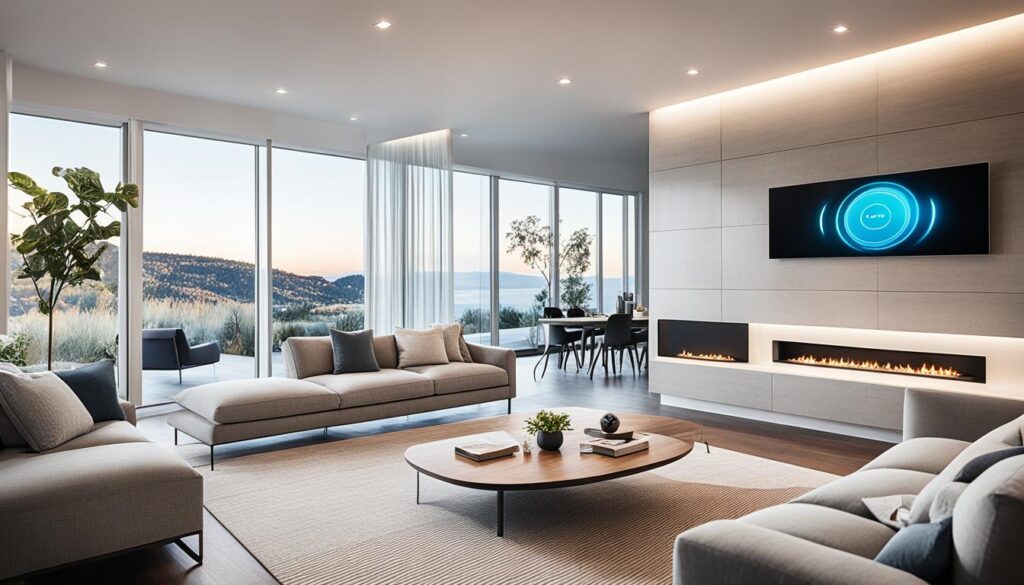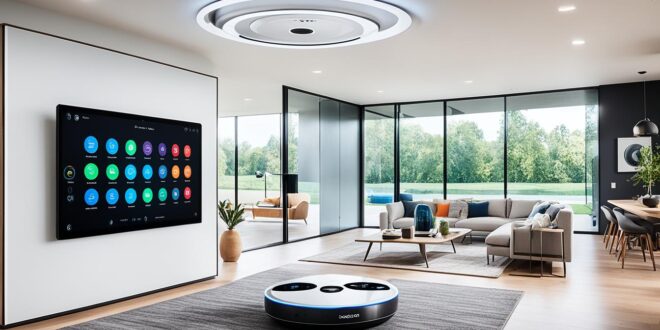Are you ready to turn your home into a smart, connected space? Setting up a home automation system might seem hard, but today’s devices make it simple. This guide is for anyone wanting to improve their living space. It’s perfect for tech-savvy homeowners or renters looking to upgrade.
Imagine having voice-controlled smart speakers1 or sleek smart plugs2 at your fingertips. These devices open up a world of convenience, energy savings, and security. But starting can be overwhelming. Let’s start with the basics to set up your dream smart home.
Voice Control: The Convenient Starting Point
Voice-controlled home automation is quickly becoming the top choice for many homeowners starting with smart homes3. Over a quarter of US adults now own a smart speaker3. This technology is becoming the main way to enter the smart home world. By 2022, smart speaker use is expected to jump to 55 percent3, showing how much people want to control their homes with voice commands.
Smart Speakers: The Gateway to Voice Control
Big names like Amazon Echo, Google Nest, and Apple HomePod have changed how we talk to our homes3. These small devices let users control smart home gadgets just by speaking. You can turn on lights, change the thermostat, or check the weather with just your voice3. Now, 72 percent of smart speaker owners use them every day3.
Smart Displays: Touchscreen Control for Your Smart Home
Smart displays are the next step after smart speakers, offering a more interactive way to manage your home4. Devices like the Amazon Echo Show or Google Nest Hub let you use voice commands and touch screens. You can watch security cameras, change lights, or adjust the temperature with ease. Smart displays are now the go-to spot for controlling your smart home, making it simple to manage your living space.
As more people use voice-controlled home automation3, smart speakers and displays are becoming the easy way for homeowners to improve their homes3. These devices make controlling your home with voice commands easy and work well with many smart devices. They’re leading the way to a more connected, efficient, and personalized home.
How to Set Up a Home Automation System
Start your smart home journey with a home automation system. You can choose from easy plug-and-play devices or full systems. There are many ways to begin5.
Smart Plugs: Automating Your Existing Devices
Smart plugs are a great first step in home automation. They turn regular devices like lamps and appliances into smart ones you can control with your phone5. With a few taps, you can schedule, monitor, and control your devices from anywhere in your home.
Smart Lights: Illuminating the Way to Automation
Smart light bulbs and switches let you control your lights easily. You can set schedules, change brightness, and pick colors for your mood or events5. These lights work well with your home automation system. They help you make custom lighting scenes and routines for your home.
Smart Thermostats: Comfort and Energy Efficiency
Smart thermostats keep your home at a comfy temperature and save energy5. They learn what temperature you like and adjust the system for you. With remote access and scheduling, they help you save on energy bills and live more sustainably.
| Home Automation Component | Typical Cost Range |
|---|---|
| Smart Plugs | $10 – $50 per device |
| Smart Lights | $10 – $100 per bulb |
| Smart Thermostats | $100 – $300 per device |
| Professional Installation | $100 – $300 |
By using smart plugs, lights, and thermostats, you can make a full home automation system. It will meet your needs and improve your comfort, convenience, and energy use5. You can do it yourself or get professional help. Either way, you can turn your home into a smart, connected place.

“Home automation is not just about convenience; it’s about creating a more efficient, sustainable, and personalized living environment.” –6
Enhancing Home Security with Smart Devices
The global market for smart home security devices is expected to hit over $135 billion by 20257. This shows how advanced technology can make our homes safer and more secure. With more IoT devices, we face more risks of cyber threats. So, it’s key to use smart security solutions that offer strong protection7.
Smart locks from brands like August and Ultraloq let us control our home access from anywhere with our phones. We can give guests or workers temporary codes easily7. Video doorbells from Arlo and Ring let us see and talk to visitors remotely, so we always know who’s at the door7. Security cameras with high-definition video, motion detection, and night vision help us watch over our homes inside and out7.
By linking these smart security gadgets with our home automation, we get the ease of a connected home and better safety for our families and property7. Voice assistants like Amazon Alexa and Google Assistant make it easy to manage our security with just our voice7. Also, geofencing lets our security systems turn on or off based on where we are, keeping our homes safe when we’re out7.
Source Links
- https://www.pcmag.com/how-to/how-to-set-up-your-smart-home-a-beginners-guide – How to Set Up Your Smart Home: A Beginner’s Guide
- https://www.safewise.com/blog/home-automation-guide-for-beginners/ – DIY Home Automation Guide for Beginners | SafeWise
- https://htacertified.org/app/articles/voice-control-in-the-smart-home/ – Voice Control in the Smart / Connected Home, What you Need to Know
- https://www.downersgrovehc.com/blog/home-automation-systems-diy – DIY Home Automation Systems Unveiled
- https://reolink.com/blog/home-automation-installation/?srsltid=AfmBOopH7b-twO7lK_WC738FL_ke7FWh8sdz6Ppd0evqNgiscYroSGws – Home Automation Installation: What You Need to Know
- https://www.instructables.com/Planning-a-DIY-Home-Automation-System/ – Planning a DIY Home Automation System
- https://staysafe.org/home-safety/home-security-for-smart-homes-integrating-security-with-home-automation/ – Home Security for Smart Homes: Integrating Security with Home Automation – StaySafe.org
 Gmrxe Entertainment and Information
Gmrxe Entertainment and Information




